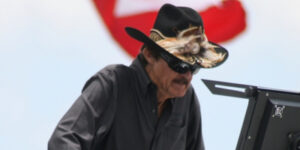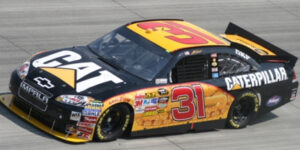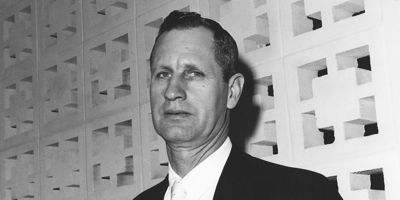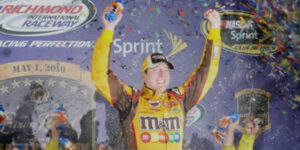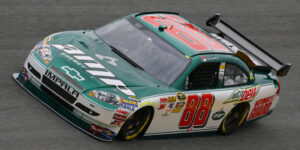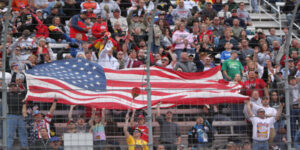Homestead-Miami, November 2009.
Denny Hamlin climbs out of his No. 11 FedEx Toyota in victory lane and proudly proclaims, “I promise you within the next two years this team is going to win a championship.”
The impending offseason brought predictions of Hamlin being the favorite in 2010. NASCAR nation marked he and his Joe Gibbs Racing team as the ones to dethrone Jimmie Johnson. Everything looked good on paper but preseason favorites had hardly risen to the occasion in the past, I.E. Carl Edwards.
[media-credit name=”CIA Stock Photo” align=”alignright” width=”300″]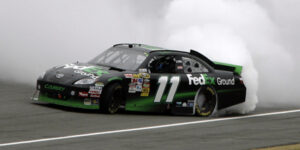 [/media-credit]Why would Hamlin be any different?
[/media-credit]Why would Hamlin be any different?
In January came the much-publicized torn ACL and how it was going to affect his season. Then came the waiting of when he would have surgery: during the season or after the season?
No matter what it was, there is no denying that NASCAR and its fans saw a growth in Hamlin over the 2010 season. From Homestead of 2009 to Homestead of 2010, a different driver graced the racetrack.
No more were the days of thinking of what could have or what should have been on the results sheet. The potential was finally met.
It was there all along, however Hamlin was spoiled when he entered the Sprint Cup Series in 2006. Success came early and often. Things appeared easy and he expected them to be and it wasn’t until the 11 team started to fall on hard times that the attitude began to change.
At Dover in 2007 he and veteran Kyle Petty got into a war of words in the garage after the two wrecked on the track. Hamlin hadn’t even been in the NSCS a full year yet, certainly not enough time for a kid to start throwing his weight around. Standing up for what he believes though, has always been one of his better qualities even when it rubbed others the wrong way.
Ironically it would be at Dover in 2010 where Hamlin again wasn’t holding back. This time it would be with Richard Childress Racing, who he was battling for in the championship.
But, there were times when Hamlin pushed too hard on the racetrack and ended up costing his team the finishes they deserved. Instead, he faulted them and said they weren’t good enough to get the job done or make the Chase.
When Tony Stewart left JGR at the end of the 2008 season, the company went through an identity crisis. They needed a leader and Hamlin, being the senior member of the company was in prime position to step up.
Joey Logano was about to embark on his rookie season and had too much learning to do; he wasn’t in a position to do anything but listen. But Hamlin, along with Kyle Busch, was more concerned with winning races than much else.
Looking back, he admits he didn’t handle things the way he should have.
Communication with Mike Ford improved, so did his trust in his crew chief. Ford has the experience and the knowledge, Hamlin the talent and once the two came together, the team hit their stride. The confidence in what was around him led Hamlin to the racetrack with the confidence that he could win every week.
That’s the Hamlin who showed up each weekend this past season and became Johnson’s worst nightmare. And as Hamlin changed, some of the fans perceptions did as well.
According to the Virginia native it was because he finally figured it out.
He finally knew what it took to contend on a consistent basis and be a championship driver. It was more than just getting in the car and driving, it was about putting together a whole race, a whole season.
All he had to do was show he knew what that was and make sure that it didn’t turn into another driver falsely predicting his own destiny.
The first test of Hamlin’s championship ability came not when he won at Martinsville in April as his knee continued to get worse, but 10 days later when he climbed aboard his car at Phoenix. Before hand Hamlin said he wasn’t “going to be stupid,” and would most likely get out of the car at the first caution to give his knee more time to heal from surgery.
Call him stupid, but he didn’t get out of the car. The fans responded with admiration, as did his fellow competitors.
Gutting it out and stepping up for his team was more important to Hamlin than any pain. Through thick and thin the team was going to stick together and their bond was growing stronger.
Knowing that many were ready to write him off for the season, Hamlin wanted to send a message – not so fast. His No. 11 team saw Hamlin wasn’t going to quit on them and in turn they became one of the top teams on pit road.
The following week they were in victory lane at Texas, winning where Hamlin’s never won before, making him a threat on many different types of tracks. The wins were huge because it brought legitimacy to the team, showing they could win on tracks that weren’t named Martinsville or Pocono.
Said Hamlin on the knee surgery in the beginning stages of the year, “I did it for the long run. I did it for the Chase. I did it for the championship.”
Three weeks later Hamlin was being praised by his competition. Not only did he conquer the toughest track on the circuit, Darlington, he swept the weekend. On Friday he beat teammate Busch in the Nationwide Series and on Saturday he beat the two Jeff’s, Burton and Gordon.
It had Gordon in awe, “That’s impressive, especially with his left knee.”
Suddenly Hamlin wasn’t being written off, he was being written as the next NSCS champion. As for his team, they also shined. In May they won the Sprint Pit Crew Challenge, firmly establishing themselves as a team to contend with – Johnson and his team found that out a few times later in the year during the Chase.
The 11 team not only continued winning, Hamlin would end the year with a series and career high eight wins, but he put himself in better situations on the racetrack. When trouble found the No. 11, Hamlin didn’t get over excited on the radio. He could have and in years past he said he probably would of. At New Hampshire in the first race of the Chase he rallied back from being spun by Carl Edwards. And in Talladega he again rallied back from going a lap down.
Maturity and patience.
The most important change: equipment wasn’t being torn up. Driver errors, such as wrecking himself at California in 2009, became a thing of the past. Patience became the name of the game, knowing when he should push the car or when he needed to take what he could get.
Hamlin even grew into his place in the sport, becoming more outspoken. A driver of the people, some called him.
Mid-year he was fine by NASCAR for comments he was making about the sport, both publicly and on his Twitter page. Twitter in fact, was another major part of his year, as he shared his journey through the season with fans. He posted pictures of traveling home with winner’s trophies or attending basketball games.
He was open and honest, just want the fans wanted: an anti-Johnson.
After longing for a driver who wasn’t vanilla or robotic, someone who could be entertaining and engaging, Hamlin stood up. What you saw was what you got. Hamlin was himself and he didn’t apologize for it, the complete package.
Not all fans were sold; there were those that called him arrogant and cocky. Far from it said Hamlin. It was just when he came to the racetrack he knew both his cars and team were going to be great and he expected to win.
It’s the same attitude that drivers such as Johnson have had the last five years. Or even Tony Stewart, who won his second title in 2005.
It’s a champion-like attitude.
In the end, Hamlin didn’t leave Homestead in 2010 with the championship. Second place in the final point standings is nothing to be ashamed of. Not after a year that was far from smooth.
He grew as a driver and an individual. He won and then he lost. He got hurt and then came back better than ever and ready to write the next chapter in his career. The lessons of 2010 should guide Hamlin into the future as he attempts to again unseat Johnson.
In a way, Johnson winning the title when he couldn’t sits well with Hamlin. Next year is another chance for him to be the guy that stops the No. 48 juggernaut. The promise he made a year ago is still alive and well and there’s no reason to believe his team won’t pick up in 2011 where they left off in 2010.
Johnson may have taken home the title, again, but it was the driver of the No. 11 FedEx Toyota for Joe Gibbs Racing who grabbed all the headlines.
This was the year of Denny Hamlin.
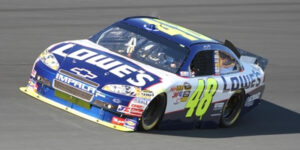 [/media-credit]The 2010 championship race was close, but just like a closer 2004 championship in which Kurt Busch beat out Jimmie Johnson by eight points, it was artificially contrived. Listening to those cheerleaders, you’d think that racing in the past were always runaways with the winner being ahead by a lap and the rest of the field just driving around. Today we have the “Lucky Dog” which allows a driver to make up a lap without racing for it. Done in the name of safety, it allows the more affluent teams to make up laps when they make an unfortunate mistake. I can remember the race at Richmond International Raceway in 1970 when Richard Petty made up multiple laps by racing for them. James Hylton won the race, but Petty wasn’t given any consideration, like today.
[/media-credit]The 2010 championship race was close, but just like a closer 2004 championship in which Kurt Busch beat out Jimmie Johnson by eight points, it was artificially contrived. Listening to those cheerleaders, you’d think that racing in the past were always runaways with the winner being ahead by a lap and the rest of the field just driving around. Today we have the “Lucky Dog” which allows a driver to make up a lap without racing for it. Done in the name of safety, it allows the more affluent teams to make up laps when they make an unfortunate mistake. I can remember the race at Richmond International Raceway in 1970 when Richard Petty made up multiple laps by racing for them. James Hylton won the race, but Petty wasn’t given any consideration, like today.


